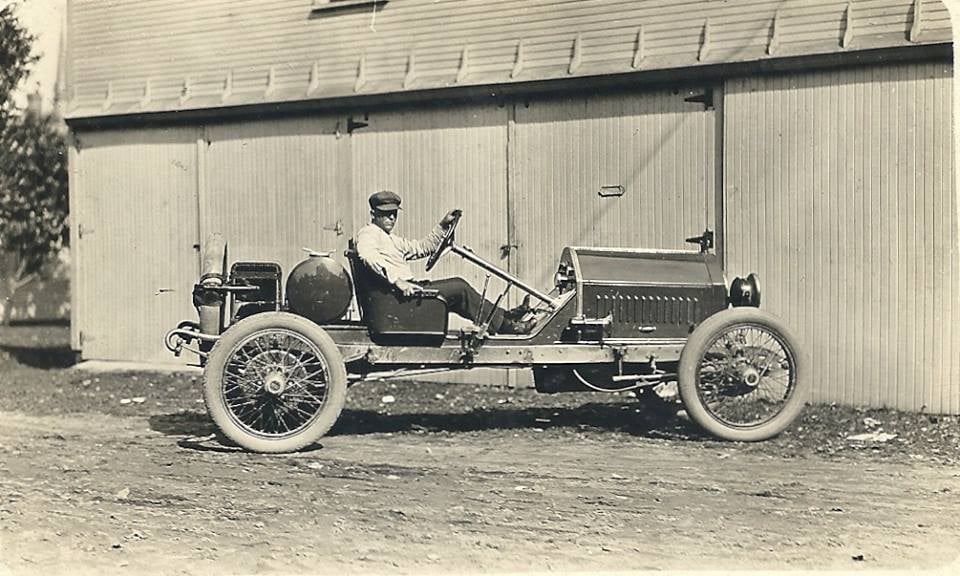Charles Mowery and the Stutz Bear Cat |
 Every generation has some new technology to dream about: be it space travel in the 1960s, or airplanes in the 1940s. In the early 1900s, however, it was the dawn of the automobile that caught the eye of Loudonville resident Charlie Mowery. Though they had existed for a few decades, automobiles were still quite rare even by 1910--especially in rural Loudonville.
Every generation has some new technology to dream about: be it space travel in the 1960s, or airplanes in the 1940s. In the early 1900s, however, it was the dawn of the automobile that caught the eye of Loudonville resident Charlie Mowery. Though they had existed for a few decades, automobiles were still quite rare even by 1910--especially in rural Loudonville.In fact, less than half a percent of the American population even owned an automobile at the start of the decade. In 1910 the Ford Model T, the cheapest car in production, still cost over $900 ($25,000 after adjusting for inflation in 2021) but what was worse, was after purchasing it you had to afford fuel and struggle to find someone to repair it in an age when the majority of roadside repairs consisted of a blacksmith shoeing a horse or fixing a wagon wheel. A horse, on the other hand, was much more affordable and reliable. Fast forward to 1915, Ford had managed to cut costs on the Model T down to approximately $500 ($11,000 in 2021) yet only 2% of the population could still afford to own one.
If Charlie hadn't yet caught the automobile bug by 1915, he was about to: that year Edwin "Cannonball" Baker set a new transcontinental record by driving from Los Angeles to New York City in only 11 days, 7 hours, and 15 minutes. In the process, he inspired countless young men (and likely women) and helped jumpstart the sport of automobile racing.
It's unknown if Charlie Mowery had even sat in an automobile before Baker made that famous first cannonball run, but if he hadn't he found one pretty quick. Thirty year old Mowery couldn't afford a car, but fortunately for him someone else in town could: H.J. BeBout. BeBout was the Vice President of the Northwestern Milling & Elevator Company, based in Loudonville. BeBout didn't just own a cheap Model T, though, he was the proud owner of a Stutz Bear Cat: a shorter, lighter version of the standard Stutz luxury car that boasted a 60-horsepower straight-four engine with a "dog house" hood, open bucket seats, monocle windscreen, and a rear fuel tank. The Bear Cat was without a doubt a real race car, in fact it was the same model that Baker made the cannonball run in. It also wasn't cheap, costing over $2,000 (nearly $53,000 in 2021).
To own a Bear Cat, BeBout must have had his own dreams of being a racer but somehow Mowery convinced him to hand over the keys. Soon, the roar of an engine and a cloud of dust was Mowery's trademark signature as he tore up the dirt path known as Ashland Road (now State Route 60), getting a feel for handling the machine. Impressed by his skills behind the wheel, BeBout let Mowery enroll in the Ohio Amateur Championship that fall.
The OAC was not your average street race. It was a grueling 100-mile marathon held on a dirt horse track at the Columbus Driving park. A pair of goggles and a silk scarf were the only things keeping the dust out of Mowery's eyes and mouth, and at best a primitive seatbelt holding him into the bucket seat. Racing was dangerous, for a number of reasons, namely the lack of safety features on the automobiles but also the inevitable danger of letting a dozen or more tin-cans with four bald tires, no cab, and an exposed gas tank strapped to the back zoom around a half-mile dirt track.
The first fatality happened before the race even began: twenty-three year old Douglas Gray was testing out his own Stutz racer when he blew a rear tire, overturning the auto and crushing his skull. Clarence Robinson, a twenty-seven year old African-American chauffeur employed by Gray's father, was also riding in the Stutz at the time: his right side was crushed and his skull fractured. Gray was killed on impact, Robinson was rushed to the hospital where he, too, ultimately succumbed to his injuries.
Despite the tragedy, the race was underway less than an hour later. Little is known of how the race played out, as Gray and Robinson's demise was the focus of all the headlines, but fortunately no other major accidents were reported. At the end of the day Dr. Harry McCord of Cincinnati took home the top spot after finishing in 1 hour, 42 minutes, and 12 seconds. Harry McNay, also of Cincinnati, finished second. Charlie Mowery, managing to keep BeBout's Bear Cat in one piece, came third, followed by W.G. Lake of Mt. Vernon in fourth.
Despite his success placing in the 1915 Ohio Amateur Championship, it appears Mowery's racing career was short lived. The only other record of him competing took place at the 1916 Allen County Fair, where he competed against the top drivers from Ohio, Indiana, Michigan, and Illinois, however the results of those races are unknown.
In 1920, he purchased a cider press and established Mowery Cider Mill at his home in Loudonville. He also served as a long-time trustee of Green Township, and spent a stint as Ashland County Commission from 1944-1948, before passing away in 1956.

